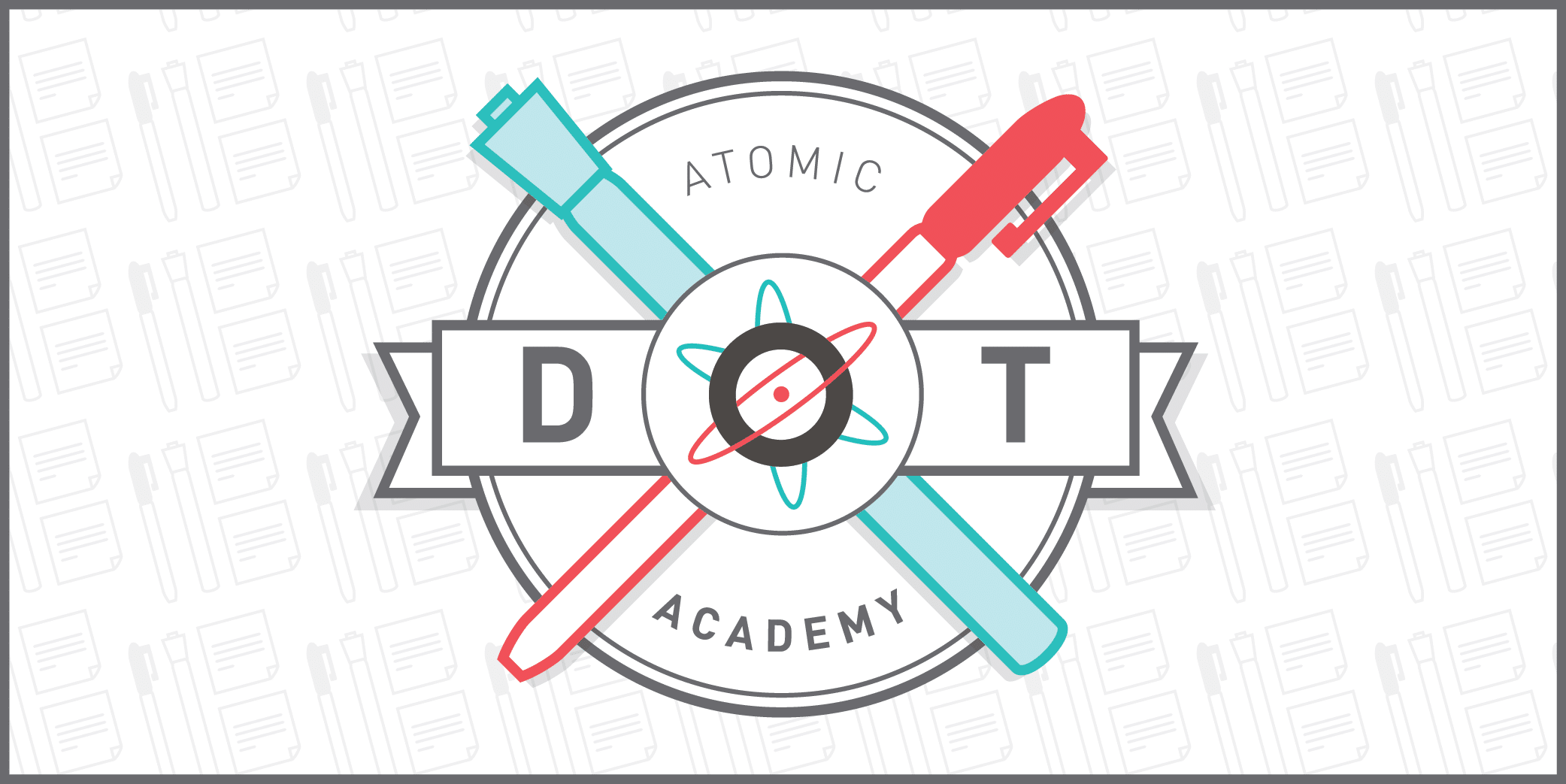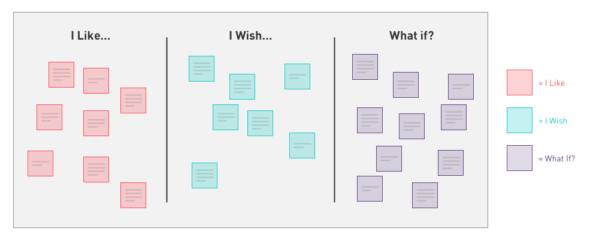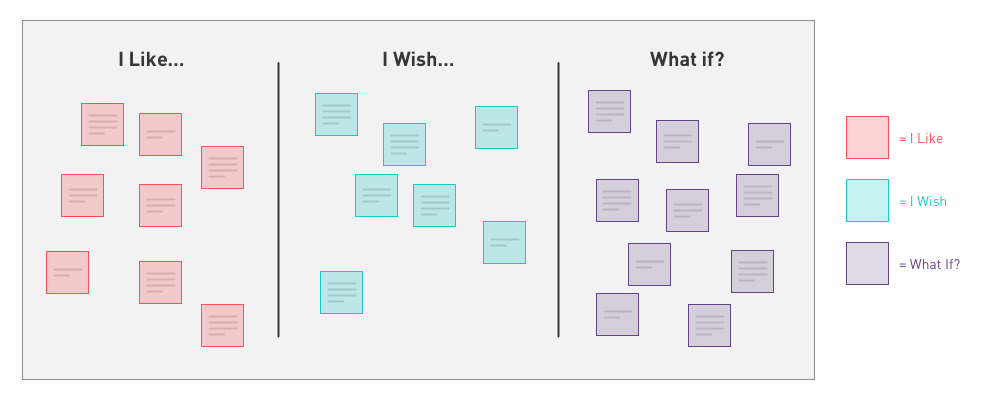Welcome to our series on Design Thinking Methods and Activities. You’ll find a full list of posts in this series at the end of the page.

Today’s activity is I Like, I Wish, What If.
| Primary Goal | To quickly solicit feedback |
| When to Use | After a review of some sort (ex. design review or idea brainstorm) |
| Time Required | 15-30 minutes depending on group size |
| Number of Participants | 2-100+! |
| Who Should Participate? | Any participants of the meeting |
| Supplies | You can perform this exercise verbally or with a large whiteboard, Post-it Tabletop Pad, Post-it notes, Sharpies, and/or whiteboard markers |
Gaining feedback is a crucial and important part of any project. However, open, positive, and constructive comments can be hard to gather without a reliable framework in place. Leaning on an activity such as I Like, I Wish, What If (IL/IW/WI) can help you collect the information you need quickly.
IL/IW/WI also gives everyone even footing. A tech lead’s feedback may vary greatly from the marketing director’s, but this exercise will help everyone deliver viewpoints in a similar fashion. It also reinforces the use of positive language. Instead of saying, “I Hate,” the participant can begin with, “I Wish.” I much prefer the happy overtones of wishes to hatred.
You can change out “What If” to “I Wonder” or “How Might I” if you prefer. It’s fun to change up the headers of this activity to fit the project as needed. Both of the alternate heading options I suggested get full marks for positivity.
Remember, the purpose of this activity is to gain positive, constructive criticism. Positivity breeds openness and emotional safety, which lead to a deeper exploration of ideas. Negativity stifles innovation and fosters an environment of isolation. Which atmosphere would you prefer to work in? The happy, fun times one, duh.
Now let’s get started.
1. Prep for the Exercise
First, choose a focal point for your activity. This could include things like:
- Design work (wireframes, logo designs, marketing concepts, etc.)
- Any type of vision or plan (from a business analysis to a blueprint)
- The overall, general impressions of a day of workshops or a long meeting
It’s possible to conduct this activity verbally, but make sure to have a good notetaker on-hand to document everyone’s responses.
If you choose the Post-it route, gather enough Post-it notes for each participant. You can use three different colors to make it easier, or just ask participants to mark each Post-it with the appropriate title of “I Like,” “I Wish,” or “What If.”
You could also write the headers on a large whiteboard or giant Post-it notes and ask participants to tack notes under the corresponding categories.

2. Collect Likes, Wishes, and What Ifs
Allow each participant 10 minutes to fill two to five Post-its for each category. Then have everyone in the meeting discuss their feedback one-by-one. Make sure you allow each participant an uninterrupted amount of time to express all of their ideas and pieces of feedback.
After each person has had a turn, open the floor for further discussion and reactions. As new ideas and discussion unfold, try to encourage the team to build upon each other’s ideas by saying, “Yes, and…” instead of, “Yes, but…” This small change can be a discussion game-changer and possibly lead to your team’s next “a-ha!” moment.
If you do happen to run this activity with a larger group (20-100+, yes 100! Think conference, camp, or reunion), reviewing feedback one-by-one isn’t an option. Merely have participants post their feedback on a large whiteboard or giant Post-its and review the feedback later at your leisure. It can benefit large groups to read other people’s feedback, too.
The added benefit of running the activity with a larger group is that it’s self-facilitating. Set it and forget it. Because of the simplicity of the format, it needs little to no explanation to run.
3. Analyze Feedback
After you’ve gathered everyone’s input, it’s helpful to transfer it to a spreadsheet or mind map. From there, you can merge duplicates, prioritize, and plan next steps. Look for patterns in the feedback that might allow you to identify higher-level themes or ideas.
Transfer your next steps to an email, task list, or deliverable to share with stakeholders, if appropriate, so that they, too, can benefit from the post-exercise analysis.
And that’s a wrap! Let me know if this quick and easy framework has been helpful for you or if there are other terms you use to solicit feedback from others.
Atomic’s Design Thinking Toolkit
- What Is Design Thinking?
- Your Design Thinking Supply List
- Activity 1 – The Love/Breakup Letter
- Activity 2 – Story Mapping
- Activity 3 – P.O.E.M.S.
- Activity 4 – Start Your Day
- Activity 5 – Remember the Future
- Activity 6 – Card Sorting
- Activity 7 – Competitors/Complementors Map
- Activity 8 – Difficulty & Importance Matrix
- Activity 9 – Rose, Bud, Thorn
- Activity 10 – Affinity Mapping
- Activity 11 – Speed Boat
- Activity 12 – Visualize The Vote
- Activity 13 – Hopes & Fears
- Activity 14 – I Like, I Wish, What If
- Activity 15 – How to Make Toast
- Activity 16 – How Might We…?
- Activity 17 – Alter Egos
- Activity 18 – What’s On Your Radar?
- Activity 19 – The Perfect Morning
- Activity 20 – 2×3
- Activity 21 – How Can I Help…?
- Activity 22 – Cover Story
- Activity 23 – Crazy 8s
- Activity 24 – Abstraction Ladder
- Activity 25 – Empathy Map
- Activity 26 – Worse Possible Idea
This is an updated version of a post originally published in September 2018.


This article was very insightful. Thanks for the great content!
Thank you! I’m glad that it resonated with you.